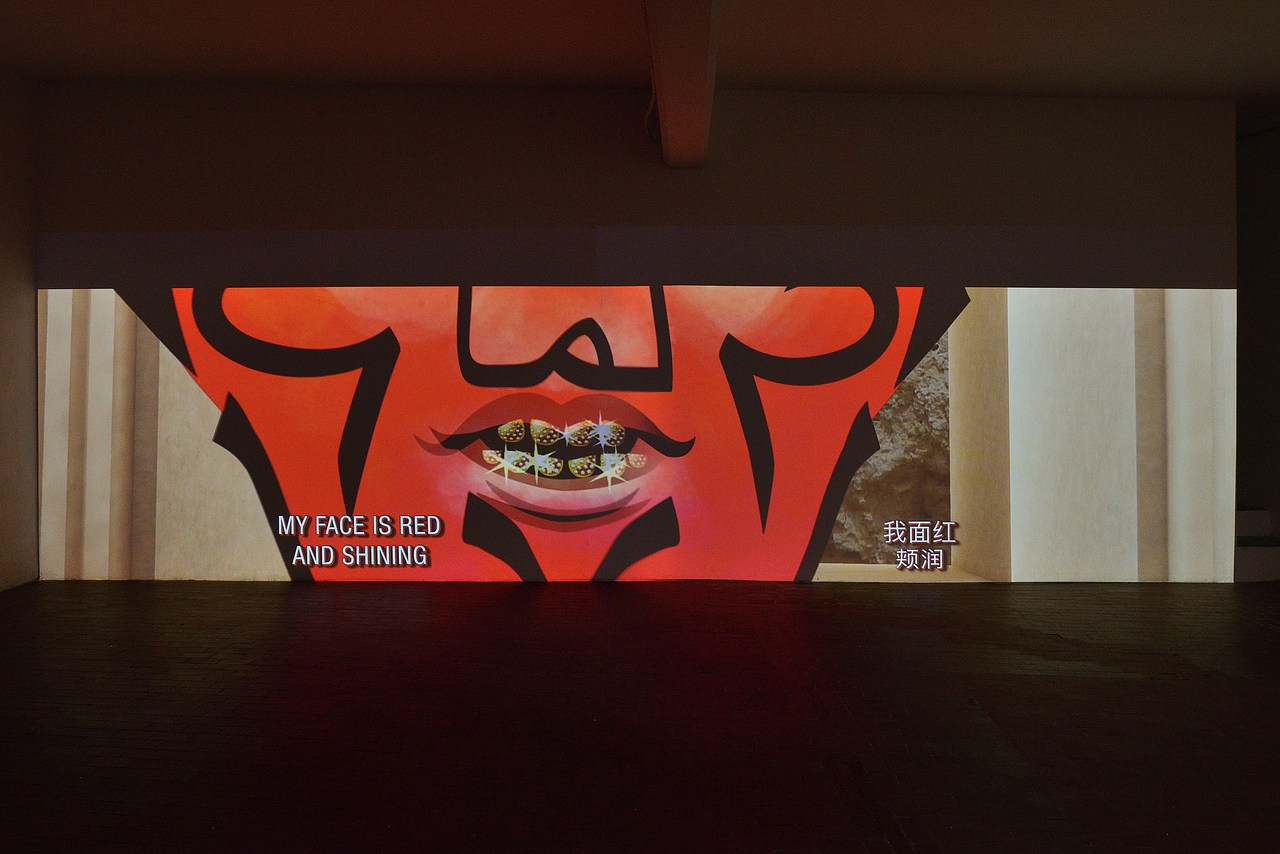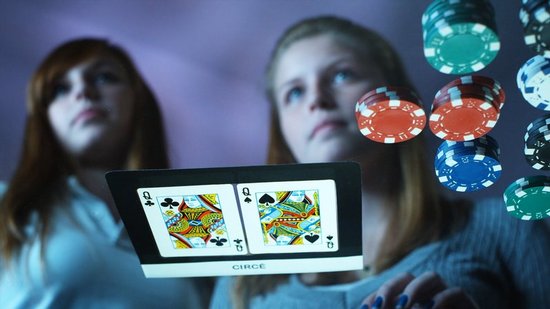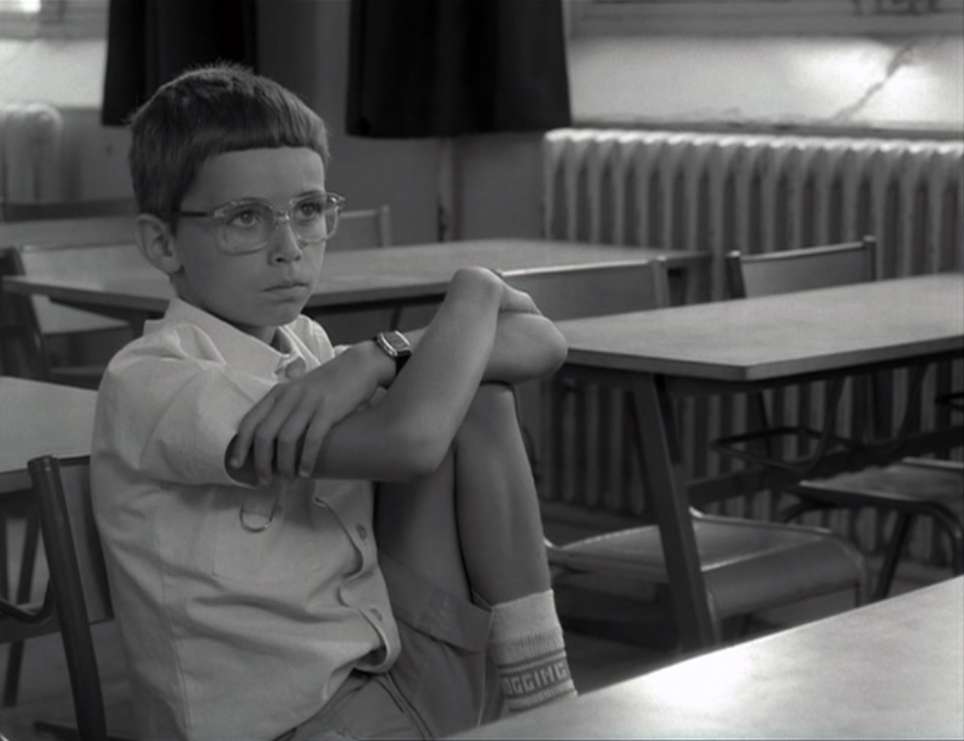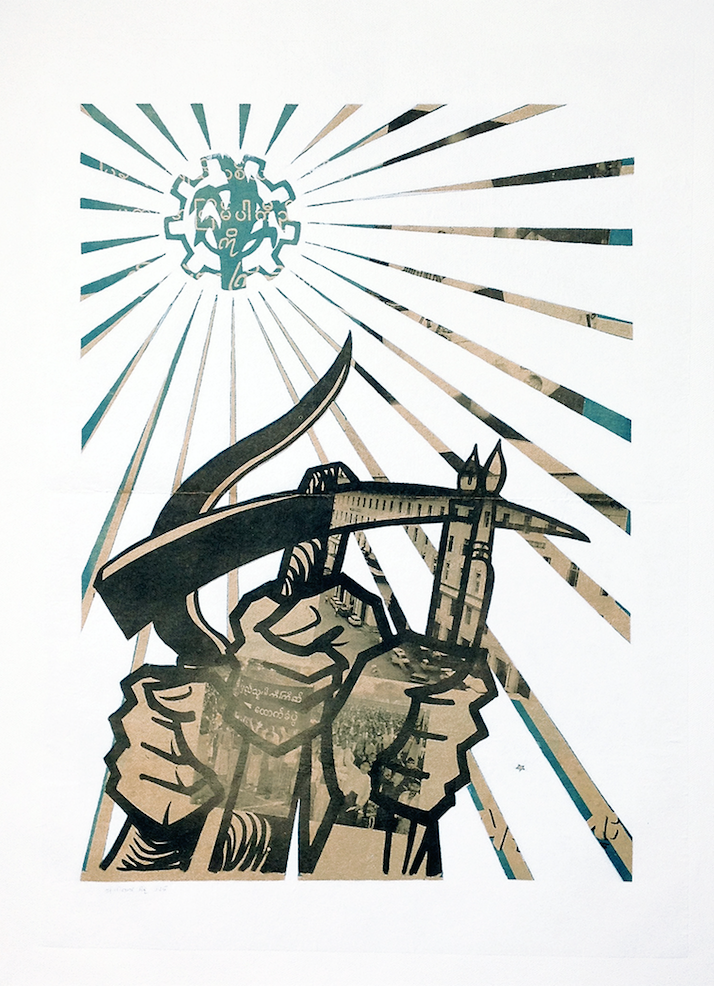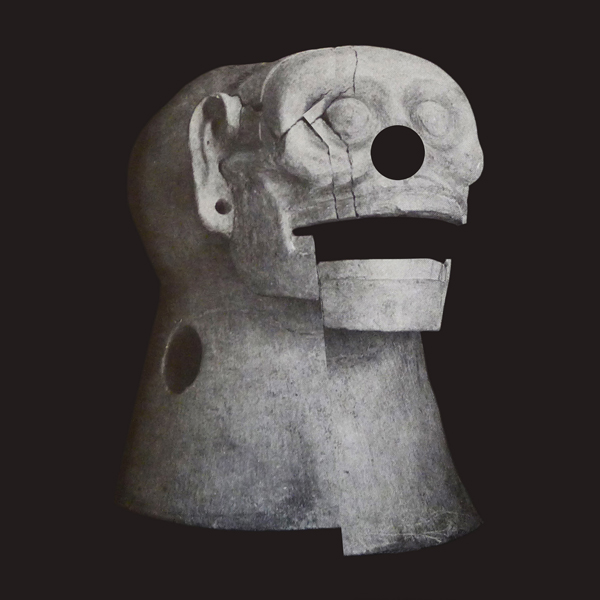
© » KADIST
Maayan Amir and Ruti Sela
In Beyond Guilt the two artists create a portrait of our generation in three parts. In Tel Aviv, in confined spaces such as toilets or bar of hotel rooms, they create situations in which participants answer questions and describe themselves. Camera in hand, there is little editing in their works, leaving a rather crude result.

© » KADIST
Ho Rui An
Embracing the conflicting negative and positive affect of the horror genre, Ho Rui An’s film Student Bodies is a self-described work of “pedagogical horror,” that organizes social, political, and economic events in Asia around the motif of the student body. Bound together by a suspenseful, eerie soundtrack, the film temporally cycles through its separate, though thematically interrelated, phenomena and events centering Asian students. Using the student body motif as a human signifier of varied connotations, the film follows phenomenon ranging from the Ch?sh?

© » KADIST
Ho Rui An
The lecture performance, Screen Green takes the telecast of a speech made by the Prime Minister of Singapore, Lee Hsien Loong, during which he was pictured against a homogenous green backdrop commonly used for visual effects or post-production in film, as a point of departure. Taking the lush, botanical landscape of Singapore, administered through a series of governmental gardening efforts, Ho offers a speculative narrative through the metaphor of a space of future possibilities that are simultaneously a method to limit and modulate its citizens.

© » KADIST
Anri Sala
Ghost Games , follows the enigmatic dance of crabs “steered” by a flashlight in the night of darkness of a South American beach. The video produces a surreal impression, typical of Sala’s work, with no plot in the classical sense, no story being told. Like in Blindfold (2002), in which a sunrise is reflected in urban billboards, and Time After Time (2001), in which the figure of a horse emerges from darkness lit by the headlights of an automobile, Sala likes to explore the phenomenon of light and its effects; In Ghost Games , he uses the threatening reflection of the flash light through the darkness of the beach.

© » KADIST
Heba Amin
Heba Y. Amin’s 2016 film As Birds Flying uses found footage from drones in an allegorical response to a 2013 news story of a migratory bird with an electronic device attached to its ankle who was detained by the Egyptian authorities, suspected of espionage. For the artist, the story represents the paranoia and suspicion endemic to a context of global surveillance. Filmed from a bird’s-eye perspective, or a spy’s perspective, the images span the savannas and wetlands of Galilea.

© » KADIST
Maryam Hoseini
Secrets Between Her and Her Shadow 10 by Maryam Hoseini is from a series of paintings of the same title that are inspired by the story Layla and Majnun – an Arabic love story about Majnun, a 7th century Bedouin poet, and his lover, Layla. Hoseini’s compositions are visually inspired by the illustrations accompanying the Khamsa of Nizami , a manuscript of five poems, including Layla and Majnun , produced by the Persian poet Nizami in the 1590s. Unlike the original tale, Hoseini’s paintings focus entirely on Layla, any male characters are purposefully erased from this narrative.
![A World Undone [Protolith]](https://kadist.org/wp-content/uploads/2017/11/IMG_Installation-view-3_WEB.jpg)
© » KADIST
Nicholas Mangan
Executed in 2012, A World Undone revolves around a single, metaphorically rich substance, drawing on geological research into an ancient mineral, Zircon, unearthed in remote Western Australia. These rocks are now studied, like a time capsule, revealing intriguing clues about the state of the planet more than 4 billion years ago. Mangan procured a sample of the material and reduced it to a fine dust that he then filmed, in flux, with a high-speed video camera.

© » KADIST
Seba Calfuqueo
Alka domo by Seba Calfuqueo is a performative video work that recontextualizes a story about Caupolicán, the Mapuche toki (meaning symbol of strength and perseverance in the face of adversity). Caupolicán was elected military leader by the Mapuche people of Chile after successfully completing the challenge of holding a log on his shoulders for two days. Caupolicán led the Mapuche army in the first uprising against the Spanish conquistadors from 1553 to 1558.

© » KADIST
Gabriella and Silvana Mangano
There is no there by Gabriella and Silvana Mangano is a black and white looped video with sound, in conjunction with a live performance. The work is inspired by the Blue Blouse, a political propaganda theater movement which spread across the Soviet Union in the mid-1920s. More specifically, the work takes the form of ‘Living Newspapers’, which were performances based on topical news events.

© » KADIST
Slavs and Tatars
Wheat Mollah ( 2011) is one of Slavs and Tatars composite object. The title Wheat Mollah has various interpretations, from “master” or spiritual authority for Shiites and “friend” for Sunnis. The turban is also worn in a diversity of cultures and religions in Africa, Asia and India.

© » KADIST
Michelle and Noel Keserwany
Les Chenilles by Michelle and Noël Keserwany is a sensual film that translates the source of women’s oppression into the means for their liberation. In this narrative film, protagonists Asma and Sarah meet while working as waitresses in France. They both come from the Levant and, each in their own way, carry burdens of the past and the consequences of colonialism.

© » KADIST
Amie Siegel
Winter is a film installation of multiple tenses—shot in the recent past, depicting an unknown future, unfolding (and changing) in the present of the exhibition. Shot in the white-washed homes of New Zealand architect Ian Athfield, including his own communal compound high above Wellington harbor, the film suggests various temporal and cultural conditions of instability, hinting at concerns of global warming and nuclear accidents, pushing at the boundaries of science fiction, stripped of narrative explication and causal explanation.

© » KADIST
Ruth Patir
Historical representations of the female form and the clichés and misunderstandings that surround them have been the subject of recent research and historical revision. Marry, Fuck, Kill by Ruth Patir reimagines sculptures of fertility goddesses from ancient times as real-life women by animating them as a moving sculptural bodies. In a country such as Israel, where the presence of ancient ruins are common, if not everyday for some, this work speaks both to the present and the distant past, and draws continuities between.

© » KADIST
Amie Siegel
Berlin Remake ( 2005) combines extracts of East German films with images filmed by the artist in Berlin. While staying in Berlin, the artist found the locations where the official films were made and she juxtaposes the two in a synchronised double projection. Therefore on one screen there is Berlin between 1945 and 1989 and on the other Berlin in 2004.

© » KADIST
Amor Muñoz
Yuca_tech: Energy by Hand is an installation by Amor Muñoz that resulted from a local technology lab in a small village in the Yucatán henequen zone, in the Mayan region of Mexico. The lab was designed as a community technology space that focuses on developing forms of production through collaboration rather than through capitalist means of production based on private ownership and driven by financial profits. More specifically, the workshop and activities of the lab merge Indigenous crafting techniques with open-source technologies and solar energy to create technology-based artworks.

© » KADIST
Maya Watanabe
Maya Watanabe’s video installation Bullet unfolds within the context of the Peruvian justice and forensic systems. During the Peruvian internal armed conflict that occured between the subversive group Sendero Luminoso (Shining Path) and the Peruvian military from 1980-2000, approximately 21,000 people, civilians, and guerilla fighters were killed. Most of the killings that were perpetrated by the military during this period of political upheaval were later deemed extrajudicial acts, and almost all of them were carried out with firearms.

© » KADIST
Maya Watanabe
Three men with their backs to each other, dressed similarly in dark colors, stare straight at the camera. They individually deliver sacred lines from the Torah, New Testament, and Qur’an in their representative languages: Old Hebrew, Greek, and Old Arabic. As the camera slowly rotates around the trio, the men begin to perform traditional manifestations of each religious cult: Torah Cantillations, Gregorian Chants, and tilawat of Al-Qur’an.

© » KADIST
Maya Watanabe
In Escenarios (Sceneries) Maya Watanabe films forgotten wastelands through a series of 360° camera movements that highlight the dramatism and visual richness of terrain that would be otherwise forgotten. Her choice to depict these lands is a reference to the devastated geography that now grips her Peru after decades of destruction from a grueling Civil War—the second largest internal conflict in the history of Latin America. Through the videos of this post-conflict territory she alludes at once to the sombre episode in Peru’s recent history, as well as her memory of it: fragmented and contused.

© » KADIST
Maya Watanabe
El Contorno (Outlines) is a three-channel video installation that features five actors performing a script—at times individually and at times in unison—choreographically moving across an indistinct urban space. As the view shifts from one performer to another we notice that they are all in close proximity and that the feed from all three channels was simultaneously filmed. The scene unravels with actors moving in and out of view in an elaborate negotiation between their bodies and the camera’s movements.

© » KADIST
Marwan Rechmaoui
Drawing & Print (Drawing & Print)
Throughout his career, Marwan Rechmaoui has maintained a drawing practice. During the Covid-19 pandemic lockdowns the artist spent his evenings recording thoughts and imagery on paper, inspired by events happening around him, music, his garden, and the news. These drawings are contemporaneous in their concerns and are indexical of a destitute time and space in the aesthetics they conjure.

© » KADIST
Masaya Chiba
Fairy #2 (2011) depicts a surreal scene of roughly assembled household ephemera, potted plants, and a faintly visible figure rendered in thin red line. The picture shows a grouping of tables and stools arranged in a dense cluster. A collection of objects, all brown or burlap-hued, cover their surfaces: ceramic pots, wooden planks, roughly geometric wooden sculptures, and even a small figure that perches precariously atop of miniature cube alongside a forked wood finish form.

© » KADIST
Marwan Rechmaoui
Drawing & Print (Drawing & Print)
Throughout his career, Marwan Rechmaoui has maintained a drawing practice. During the Covid-19 pandemic lockdowns the artist spent his evenings recording thoughts and imagery on paper, inspired by events happening around him, music, his garden, and the news. These drawings are contemporaneous in their concerns and are indexical of a destitute time and space in the aesthetics they conjure.
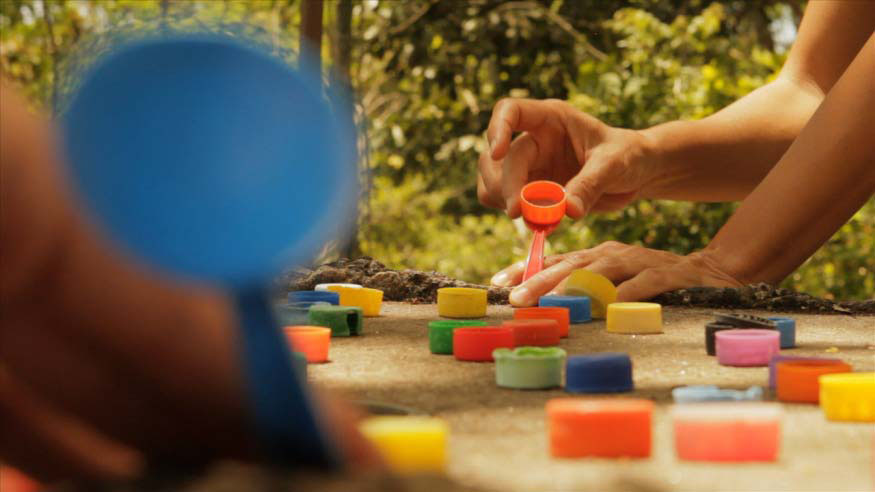
© » KADIST
Donna Conlon and Jonathan Harker
In Tapitapultas (2012), Donna Conlon and Jonathan Harker comment on mass consumerism and pollution by way of a game they invented. The artists used disposable spoons as catapults to shoot thousands of plastic bottle caps at a hole in a concrete platform. The platform was once part of a U. S. military installation in the Panama Canal Zone, and it is now an observation deck in a nature park.

© » KADIST
Köken Ergun and Tashi Lama
Nepal and China signed an agreement for the Belt and Road Initiative (BRI) in 2017. The BRI is a strategy that was set forth by China in 2013 to expand its influence by building a network of economic corridors around the globe. BRI projects in Nepal include the Kathmandu-Kerung Railway, the Galchhi-Rasuwagadhi-Kerung 400 kilovolt transmission line, the 762 megawatt Tamor hydroelectric dam, and the 426 megawatt Phukot Karnali run-of-the-river hydropower project.

© » KADIST
Jay Chung and Takeki Maeda
Jay Chung and Q Takeki Maeda remake a clip from the 1970s they found on the internet, and without really changing this archive material, displace it by imitating the staging and the acting with scrupulous precision. The slightest details are reproduced identically with great minutiae. The facial expressions are absurd, the prim attitude makes no sense.

© » KADIST
Pooja Gurung and Bibhusan Basnet
DADYAA: The Woodpeckers of Rotha by Pooja Gurung and Bibhusan Basnet illuminates a unique and seldom seen international perspective on indigenous cultures and contemporary social issues in the Nepali context. A small masterpiece, the work engages with one of the most pressing social issues in Nepal, mass migration and the dissolving of social fabric in rural areas. The story begins with an old couple, Atimaley and Devi, who live in a village in Jumla, in the highlands of Western Nepal.

© » KADIST
Musquiqui Chihying and Gregor Kasper
Addressing the legacy of colonialism, The Guestbook by Musquiqui Chihying and Gregor Kasper is a slow-paced, black-and-white film exploring the German colony of Togoland, now the Republic of Togo. The guestbook in question—a thin, battered copy that Do Do, the Togolese protagonist of the film, finds in Berlin’s State Library—is filled with the signatures of colonial-era explorers. The plot follows Do Do as he seeks out Treptower Park, where the JAZZ musician Kwassi Bruce was once exhibited in a human zoo in the first German Colonial Exhibition.

© » KADIST
Jonas Van and Juno B
Jonas Van and Juno B’s video work Kebranto is anchored by the figure of Boitatá, a snake that is part of the imaginary Guaraní communities that live between the current nation-states of Argentina, Brazil, Paraguay, and Uruguay. The mythical figure Boitatá is a protector of jungles and forests. In GuaraníBoitatá is the union of two words: Mbói (snake) and tatá (fire).

© » KADIST
Köken Ergun and Satyam Mishra
Nepal and China signed an agreement for the Belt and Road Initiative (BRI) in 2017. The BRI is a strategy that was set forth by China in 2013 to expand its influence by building a network of economic corridors around the globe. BRI projects in Nepal include the Kathmandu-Kerung Railway, the Galchhi-Rasuwagadhi-Kerung 400 kilovolt transmission line, the 762 megawatt Tamor hydroelectric dam, and the 426 megawatt Phukot Karnali run-of-the-river hydropower project.

© » KADIST
Angela Detanico and Rafael Lain
Letters of the Greek alphabet glisten on a black background. When a letter appears, there is a sound. Each letter corresponds to a star in the sky.
Maya Watanabe
Drawing on her background in theater design and direction, Maya Watanabe is known for her multi-channel video installations that explore the relationship between language, collectivity, identity, and space...
Chantal Edie and Zacharie Ngnogue
Chantal Edie and Zacharie Ngnogue are a photography duo who channel their personal experiences into social commentaries...
Ho Rui An
The artist, writer, and researcher Ho Rui An probes histories of globalization and governance, performing a detournement of dominant semiotic systems across text, film, installation, and lecture...
Amie Siegel
- year born: 1974
- gender: female
- nationality: American
- home town: Chicago, Illinois
Marwan Rechmaoui
- location: Bayrut, Al-Lubnan
- year born: 1964
- gender: male
- nationality: Lebanese
John Wood and Paul Harrison
John Wood and Paul Harrison have been working collaboratively since 1993, producing single screen and installation-based video works...
Ana Vaz
Ana Vaz is an artist and filmmaker whose works speculate on the relationships between self and other, and myth and history, through a cosmology of signs, references, and perspectives...
Ad Minoliti
Ad Minoliti is a painter who combines the pictorial language of geometric abstraction with the perspective of queer theory...
Leung Chi Wo and Wong Sara
Leung Chi Wo tends to highlight in his art the boundaries between viewing and voyeurism, real and fictional, and art and the everyday...
An-My LE
- location: New York, New York
- year born: 1960
- gender: female
- home town: Saigon, Vietnam
Mary Ann Aitken
Mary Ann Aitken was known to be very private about her art practice; she was considered somewhat of an outsider by her peers affiliated with the second wave of Detroit’s Cass Corridor arts movement...
Olive Martin and Patrick Bernier
Patrick Bernier and Olive Martin are a duo of artists collaborating since 1999...
Christine Sun Kim and Thomas Mader
Christine Sun Kim and Thomas Mader have been collaborating for the last 5 years, covering communication in a variety of formats such as recording an overnight shipment from Berlin to New York ( Recording Contract , 2013), compiling 24 hours of invited contributors’ studio time ( Busy Day , 2014), and using the arm game, a combination of body and face, in order to describe a series awkward situations ( Classified Digits , 2016)....
Angela Detanico and Rafael Lain
Linguists, semiologists, and graphic designers by training, Angela Detanico and Raphaël Lain consider the use of graphic signs in society...
Jay Chung and Takeki Maeda
Jay Chung and Takeki Maeda’s practice is characterized by performance, which often involves weighty unsettling humour...
Ruth Patir
Ruth Patir works with video and performances that complicate facile separations of public and private spheres...
Etel Adnan and Lynn Marie Kirby
Visual artist, poet, and essayist Etel Adnan writes what must be communicated through language, and paints what cannot...
John Lucas and Claudia Rankine
John Lucas and Claudia Rankine are interdisciplinary thinkers and makers committed to exploring the nuances of race and power in our daily lives...
Jane Jin Kaisen and Guston Sondin-Kung
Working with narrative experimental film, multi-channel video installation, performative video art, photography, and text, Jane Jin Kaisen engages themes of memory, trauma, migration and translation at the intersection of personal and collective histories...
Gabriella and Silvana Mangano
Gabriella Mangano and Silvana Mangano are an artistic duo and identical twins known for their collaborative and performative video practice...
Jonas Van and Juno B
Although Jonas Van and Juno B do not belong to a collective, this collaborative video reflects their individual practices and their complex subjectivities...
Donna Conlon and Jonathan Harker
- location: Panama City, Panama
- year born: 1966
- nationality: American and Ecuadorian
Jordan Ann Craig
Jordan Ann Craig is a Northern Cheyenne artist born and raised in the Bay Area; she invests her work with a strong interest in Indigenous culture and the history of its destruction by settlers...
Lenka Clayton and Phillip Andrew Lewis
Lenka Clayton and Phillip Andrew Lewis’s collaborative practice is social at its core: it engages with and connects communities outside of the so-called art world in both production and presentation...
Ayan Farah
Ayan Farah spends considerable time travelling: to Israel, the Somali desert or to Sweden where her mother lives...
Maayan Amir and Ruti Sela
Maayan Amir and Ruti Sela, two young Israeli women artists work collaboratively or individually by project...
Maryam Hoseini
Maryam Hoseini makes delicate, figurative paintings to investigate the political, social, and personal conditions of identity and gender...
Ei Arakawa and Sergei Tcherepnin
Ei Arakawa and Sergei Tcherepnin began their audio-visual and performative collaboration in 2007...
Ana Navas
Ana Navas’s practice deals with the vulgarization of modern art, understanding the term vulgar in its original sense of being appropriated by common people...

© » APERTURE
about 5 months ago (12/01/2023)
For the past two decades, An-My Lê has used photography to examine her personal history and the legacies of US military power, probing the tension between experience and storytelling....
-
1980-1989
Jean-Marie Straub and Danièle Huillet
1982En rachâchant is based on the short story Ah! Ernesto! (1971) by Marguerite Duras in which the child Ernesto does not want to go to school anymore as all that he is taught are things he does not know...
-
1990-1999
John Wood and Paul Harrison
1996One of John Wood and Paul Harrison’s earliest works, Device features Harrison performing a series of actions, assisted by the titular ‘devices’, that use physics to force his body into unusual and uncomfortable positions...
John Wood and Paul Harrison
19973-Legged is an early video work by John Wood and Paul Harrison in which they appear with their legs tied together (as one would do in a three-legged race)...
-
2000-2009
Mary Ann Aitken
2002Untitled (Boom Box, Double-Sided) by Mary Ann Aitken is representational painting of a boom box on an unconventionally long canvas painted on both sides, to mimic the scale and appearance of the actual appliance...
Maayan Amir and Ruti Sela
2003In Beyond Guilt the two artists create a portrait of our generation in three parts...
Amie Siegel
2005Berlin Remake ( 2005) combines extracts of East German films with images filmed by the artist in Berlin...
Jay Chung and Takeki Maeda
2009Jay Chung and Q Takeki Maeda remake a clip from the 1970s they found on the internet, and without really changing this archive material, displace it by imitating the staging and the acting with scrupulous precision...
Mary Ann Aitken
2009Untitled (Diptych) by Mary Ann Aitken is a pair of paintings; one entirely abstract and the other a hybrid of representational and abstract elements...
Pauline Boudry and Renate Lorenz
2009Salomania sees choreographer and filmmaker Yvonne Rainer and artist Wu Tsang rehearse scenes from Valda’s Solo , a chapter of a film Rainer made in 1972 after having seen women perform the dance of the seven veils in Alla Nazimova’s 1923 silent film Salomé ...
-
2010-2019
Jane Jin Kaisen and Guston Sondin-Kung
2010The Woman, The Orphan, and The Tiger begins with the sound of women’s voices describing histories of violence, of things repressed and silenced...
Leung Chi Wo and Wong Sara
2010Photojournalist with Two Cameras restages a portrait of a photojournalist from the background of an old photograph of protest published in South China Morning Post on January 10, 2010 under the headline “Return of the Radicals: Recent angry protests are nothing new.” The photojournalist in the photograph, probably from a protest of earlier decades, was capturing the scene of a protester’s arrest while wearing two cameras...
Olive Martin and Patrick Bernier
2010The Mohawk, the emblematic Frontier river in the period of American colonisation, is here a cable of data transmission, and the 7 Sultans Casino is a virtual destination, one of the three hundred online casinos hosted by the servers located in Kahnawake, a small native american indian reserve to the south of Montreal...
The Propeller Group and Superflex
2010Fade In (the whole title of the film is actually the entire five page script) is a collaboration with the Danish artist collective Superflex (group of freelance artist–designer–activists committed to social and economic change, founded in 1993 by Jakob Fenger, Rasmus Nielsen and Bjørnstjerne Christiansen)...
Leung Chi Wo and Wong Sara
2010Office Lady with a Red Umbrella restages a figure from a 1980 postcard made from a photograph from 1950’s...
Võ An Khánh
2010In Extra Curriculum Political Science Class 7/1972 , a group of women walk bare-foot and single file towards Dat Mui Mangrove in Ca Mau Province to attend ‘political science class’...
An-My LE
2010The print Patient Admission, US Naval Hospital Ship Mercy, Vietnam (2010) features an Asian Buddhist monk and an American Navy Solider on board the Mercy ship –one of the two dedicated hospital ships of the United States Navy– sitting upright in their chairs and adopting the same posture...
Maya Watanabe
2011El Contorno (Outlines) is a three-channel video installation that features five actors performing a script—at times individually and at times in unison—choreographically moving across an indistinct urban space...
Masaya Chiba
2011Fairy #2 (2011) depicts a surreal scene of roughly assembled household ephemera, potted plants, and a faintly visible figure rendered in thin red line...
Ei Arakawa and Sergei Tcherepnin
2011Part of a series entitled “Looking at Listening”, 2011, the piece invited the spectator to experiment and consider sound as a kinetic and synesthetic process, where multiple experiences and senses can cross...
Tun Win Aung and Wah Nu
2011Tun Win Aung and Wah Nu initiated the series 1000 Pieces (of White) in 2009, as a way to produce objects and images as a portrait of their shared life as partners and collaborators...
Ana Teresa Fernández
Drawing & Print
2011(Drawing & Print) The artist writes about her work Borrando la Frontera, a performance done at Tijuana/San Diego border: “I visually erased the train rails that serve as a divider between the US and Mexico...
Nicholas Mangan
2012Executed in 2012, A World Undone revolves around a single, metaphorically rich substance, drawing on geological research into an ancient mineral, Zircon, unearthed in remote Western Australia...
Donna Conlon and Jonathan Harker
2012In Tapitapultas (2012), Donna Conlon and Jonathan Harker comment on mass consumerism and pollution by way of a game they invented...
Ana Roldán
2012Ana Roldán’s Primeval forms series looks up close at the fecund shapes of plants often found in the artist’s native Mexico...
Ana Roldán
2012Ana Roldán’s Displacements works use images taken from a 1970s exhibition catalogue for an exhibition called The Death in Mexico...
Amie Siegel
2013Winter is a film installation of multiple tenses—shot in the recent past, depicting an unknown future, unfolding (and changing) in the present of the exhibition...
Maya Watanabe
2013Three men with their backs to each other, dressed similarly in dark colors, stare straight at the camera...
Amor Muñoz
2014Yuca_tech: Energy by Hand is an installation by Amor Muñoz that resulted from a local technology lab in a small village in the Yucatán henequen zone, in the Mayan region of Mexico...
Maya Watanabe
2014In Escenarios (Sceneries) Maya Watanabe films forgotten wastelands through a series of 360° camera movements that highlight the dramatism and visual richness of terrain that would be otherwise forgotten...
Gabriella and Silvana Mangano
2015There is no there by Gabriella and Silvana Mangano is a black and white looped video with sound, in conjunction with a live performance...
João Maria Gusmão and Pedro Paiva
2015The artist duo João Maria Gusmão and Pedro Paiva traveled to Japan for a month to make a series of short 16mm films, often shot in slow-motion...
Christine Sun Kim and Thomas Mader
2016Indexes that either allow or inhibit the establishment of communication exist in both signed as well as spoken languages...
Seba Calfuqueo
2017Alka domo by Seba Calfuqueo is a performative video work that recontextualizes a story about Caupolicán, the Mapuche toki (meaning symbol of strength and perseverance in the face of adversity)...
Etel Adnan and Lynn Marie Kirby
Drawing & Print
2017(Drawing & Print) In conjunction with KADIST’s 2017 exhibition If Not Apollo, the Breeze , artist and filmmaker Lynn Marie Kirby performed Transmissions , a video and live reading created with longtime collaborator Etel Adnan...
Pooja Gurung and Bibhusan Basnet
2018DADYAA: The Woodpeckers of Rotha by Pooja Gurung and Bibhusan Basnet illuminates a unique and seldom seen international perspective on indigenous cultures and contemporary social issues in the Nepali context...
John Lucas and Claudia Rankine
Drawing & Print
2018(Drawing & Print) Historically, blondeness has been a signifier for desirability and beauty, speaking to “purity” — the purity of whiteness — like no other bodily attribute except, perhaps, blue eyes...
Maryam Hoseini
2019Secrets Between Her and Her Shadow 10 by Maryam Hoseini is from a series of paintings of the same title that are inspired by the story Layla and Majnun – an Arabic love story about Majnun, a 7th century Bedouin poet, and his lover, Layla...
Ruth Patir
2019Historical representations of the female form and the clichés and misunderstandings that surround them have been the subject of recent research and historical revision...
Musquiqui Chihying and Gregor Kasper
2019Addressing the legacy of colonialism, The Guestbook by Musquiqui Chihying and Gregor Kasper is a slow-paced, black-and-white film exploring the German colony of Togoland, now the Republic of Togo...
Jordan Ann Craig
2019Something To Do With Being Held by Jordan Ann Craig is inspired by a Cheyenne bead bag...
Ana María Millán
2019Interested in role-play and videogames, Ana María Millán developed workshops with different communities in order to create characters and scenarios for her animations, often in collaboration with a choreographer...
Ad Minoliti
2019In Ad Minoliti’s expansive three-panel painting Abstracción geométrico-galáctica the artist’s hallmark geometric abstractions serve as playful substitutes for more straightforward depictions of the world...
-
2020-2029
Chantal Edie and Zacharie Ngnogue
2020Au non de la liberté (Tiko drink Kumba drunk) is a photographic series by Zacharie Ngnogue and Chantal Edie that considers the correlation between those who hold power in Cameroon and how their actions affect the populations they rule in often compromising ways...
Chantal Edie and Zacharie Ngnogue
2020Au non de la liberté (Tiko drink Kumba drunk) is a photographic series by Zacharie Ngnogue and Chantal Edie that considers the correlation between those who hold power in Cameroon and how their actions affect the populations they rule in often compromising ways...
Chantal Edie and Zacharie Ngnogue
2020Au non de la liberté (Tiko drink Kumba drunk) is a photographic series by Zacharie Ngnogue and Chantal Edie that considers the correlation between those who hold power in Cameroon and how their actions affect the populations they rule in often compromising ways...
Maya Watanabe
2021Maya Watanabe’s video installation Bullet unfolds within the context of the Peruvian justice and forensic systems...
Marwan Rechmaoui
Drawing & Print
2021(Drawing & Print) Throughout his career, Marwan Rechmaoui has maintained a drawing practice...
Marwan Rechmaoui
Drawing & Print
2021(Drawing & Print) Throughout his career, Marwan Rechmaoui has maintained a drawing practice...
Jonas Van and Juno B
2021Jonas Van and Juno B’s video work Kebranto is anchored by the figure of Boitatá, a snake that is part of the imaginary Guaraní communities that live between the current nation-states of Argentina, Brazil, Paraguay, and Uruguay...
Michelle and Noel Keserwany
2022Les Chenilles by Michelle and Noël Keserwany is a sensual film that translates the source of women’s oppression into the means for their liberation...
Köken Ergun and Tashi Lama
2022Nepal and China signed an agreement for the Belt and Road Initiative (BRI) in 2017...
Köken Ergun and Satyam Mishra
2022Nepal and China signed an agreement for the Belt and Road Initiative (BRI) in 2017...
Lenka Clayton and Phillip Andrew Lewis
2022Five Hundred Twenty-Four, a single-channel video installation by Lenka Clayton and Phillip Andrew Lewis, features singers from over twenty Cleveland-area choirs counting numbers in an iterative process: one person sings “one”, then two people sing “two”, and so forth, to 524...
Miguel and Natalia Fernández de Castro and Mendoza
2022The Absolute Restoration of All Things is a collaboration by artist Miguel Fernández de Castro and anthropologist Natalia Mendoza...
Köken Ergun and Satyam Mishra
2022Nepal and China signed an agreement for the Belt and Road Initiative (BRI) in 2017...
Ana Vaz
2022Ana Vaz describes her film É Noite na América (It is Night in America) as an eco-terror tale, freely inspired by A cosmopolitics of animals by Brazilian philosopher Juliana Fausto; in which she investigates the political life of non-human beings and questions the modern idea of the exceptionality of the human species...



